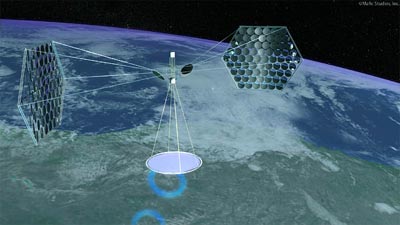War, peace, and space solar powerby Taylor Dinerman
|
| Nations that get a large percentage of their electricity from space will not have to fear that their neighbors will cut them off from gas or coal supplies. |
In the future other pipelines, such as the one that may run from the coast of Pakistan to western China, may be just as important and as vulnerable as the one that runs through Georgia. Removing this kind of infrastructure from its central role in the world’s energy economy would eliminate one of the most dangerous motivations for war that we may face in the 21st century.
If the world really is entering into a new age of resource shortages—or even if these shortages are simply widely-held illusions—nations will naturally try their best to ensure that they will have free and reasonably priced access to the stuff they need to survive and to prosper. Some of the proposed regulations aimed at the climate change issue will inevitably make matters worse by making it harder for nations with large coal deposits to use them in effective and timely ways.
The coming huge increase in demand for energy as more and more nations achieve “developed” status has been discussed elsewhere. It is hard to imagine that large powerful states such as China or India will allow themselves to be pushed back into relative poverty by a lack of resources or by environmental restrictions. The need for a wholly new kind of world energy infrastructure is not just an issue involving economics or conservation, but of war and peace.
Moving a substantial percentage of the Earth’s energy supply off the planet will not, in and of itself, eliminate these kinds of dangers, but it will reduce them. Nations that get a large percentage of their electricity from space will not have to fear that their neighbors will cut them off from gas or coal supplies. The need for vulnerable pipelines and shipping routes will diminish.
This will not happen overnight. Gasoline, kerosene, and diesel are, weight for weight and volume for volume, by far the most effective transportation fuels, but they are going to be phased out over time in favor of such things as plug-in hybrids. The world is evolving away from oil-based transportation systems. It will probably take decades, but the process is now in motion.
John Mankins’ successful experiment, beaming power from Maui to the Big Island of Hawaii, is the first real data point we have (see “A step forward for space solar power”, The Space Review, this issue). Transmitting any amount of power over nearly 150 kilometers shows what can be done. Even more important is the fact that Mankins and his team were able to navigate the government’s regulatory maze in order to achieve their goal. Getting permission from the FCC, the FAA, as well as from the state and local governments is quite an accomplishment and shows that this technology can be shown to be safe.
| If SSP were perceived as a “war avoidance” mechanism or technology, the investment logic changes. |
While most space solar power advocates believe that the basic technology already exists, the engineering challenges are huge, as are the capital requirements. Seen as a simple business proposition space solar power (SSP) is a long way from becoming a viable economic source of energy. It could be subsidized the way that wind power or terrestrial solar has been. Even with subsidies, it is hard to see that the private sector would pay for the development work due to the unknown technological risks and to the long time scale.
However, if SSP were perceived as a “war avoidance” mechanism or technology, the investment logic changes. The profit-seeking side of the private sector does not see its role as inflicting peace on an unstable and violent world. Traditionally that has been the role of governments, and in recent decades the so-called NGOs or non-profit sector.
Innovative financing propositions such as the idea that a government could promise to buy a certain amount of space-generated power at a set price may become attractive in the future. For the moment, however, governments, especially the US government, should concentrate on reducing the technological unknowns and setting the stage for future developments in the middle or end of the next decade.
The old Strategic Air Command’s motto was “Peace is our Profession”. This might be a good one for the emerging SSP industry.
